Handley Page Hampden, Donegal, October 1941
In the early hours of October 2nd, 1941 three young men from
the Royal Air Force and Royal Canadian Air Force took to their
parachutes from their stricken bomber over what they thought was
Scotland. By the early morning hours they would find that
they were in fact in County Donegal in neutral Ireland, and for
them, for now, the war was over!
Three of the men on landing made their way to the house of
local man and member of the Local Defense Force (LDF), Joseph
Carr where they were taken in and were allowed to sleep until
the morning. The remaining crew member landed in the hills
around the Glenveagh Estate, now a tourist
attraction. Given the darkness he chose to sleep in
his parachute until day light. Come the morning, he took
off down hill and was met by the estate manager of the estate,
Mr Butler, who brought him to a house of one of the caretakers.
Thus by early morning, it was known that four airmen were in
the area, the local LDF were aware and word was being sent to
the nearest irish Army Military garrison. The details of
the four began to be recorded and they were:
Pilot, Sgt. Herbert Newby, Cardiff, Wales
Observer, (Navigator) Sgt Frederick Tisdall from Moncton, New
Brunswick in Canada.
Gunner David Reid from North Berwick, Scotland
Wireless operator, Sgt. James Wakelin from Newcastle, in
England.
The Irish Army from Rockhill House in Letterkenny arrived in
the area the following morning to collect the four men and they
were sent to that barracks and allowed to stay overnight.
The following day all four were sent to Athlone and from there
they were brought direct to the Allied Internment Camp and taken
into custody.
The following message sent from the UK legation to the Air
Ministry in the early hours of the 3rd of October.
CONFIRMING PHONE MESSAGE.
DEPT. EXTERNAL AFFAIRS STATE HAMPDEN BOMBER IS REPORTED
TO HAVE CRASHED IN EARLY HOURS ON 2/10/41 REPEAT 2/10/41 IN
GLENCAN MOUNTAINS NORTH OF LETTERKENY Co. DONEGAL. CREW OF
FOUR BALED OUT AT 0300 REPEAT 0300 HOURS. AND ARE IN THE
CUSTODY OF EIRE AUTHORITIES.
NAMES - SGT. PILOT HERBERT JOHN NEWBY. SGT. FREDERICK
TISDALE CANADIAN NAVIGATOR. SGT. JAMES WATELIN WIRELESS
OPERATOR. SGT. DAVID REID REAR GUNNER. NEWBY SLIGHTLY
INJURED REMAINDER UNINJURED. REMAINS OF PLANE HAVE NOT
REPEAT NOT YET BEEN LOCATED. CREW STATE FUEL SUPPLY
EXHAUSTED AND AIRCRAFT ON FIRE WHEN THEY BALED OUT.
SEEKING FURTHER INFORMATION. ENDS
The day before the crash and arrival of the crew of four, the
Royal Air Force's 106 Squadron prepared for their nights mission
at their base at Coningsby in Lincolnshire. According to
their operations Record book and Bomber Command records, they
were detailed to bomb railway marshaling yards in the German
city of Karlsruhe in south western Germany. The Squadron
dispatched just five aircraft on this raid, to join forty other
aircraft attacking the city. A difficult to read narrative
in the ORB states: Five aircraft
were dispatched in an attack on "RAILWAY MARSHALLING YARDS
at KARLSRUHE but approximately 2 1/2 hours after take off
(21:00 hours) recall was "????" by Group. Returning
one aircraft bombed CALAIS and another an AERODROME 20 MILES
S. of LILLE. Another landed without having dropped its
bombs. One aircraft (S/L Stenner) ?/??? and bombed the
target, but the fifth (Sgt Newby) came down in Eire.
None of the other
four aircraft made it back to base, each having to land at
alternative locations in England.
And so the crew of Handley Page Hampden, Air Ministry serial
number AD768 found themselves incarcerated for the foreseeable
future.
Sgt Newby provided the following statement to the Air Attache
on the 6th October 1941 and it was sent from Dublin by that
office:
Sir,
I, 968590, Newby H.J. (Sgt.) have the honour to report
that on the afternoon of the 1st October at 6 p.m. I
took off from England on an operational trip to
Germany. When we were within 5 minutes of the
target we were recalled, but as we were so near the
target I decided to bomb, so (flying at 10,000 ft.)
at 2135 hours we bombed the target and saw a lot of
explosions caused by our incendaries. We also
started a fire. We
set course straight away but were badly harassed by
searchlights and flak, and I had to take violent
evasive action to avoid being caught or hit. At
the French border we were intercepted by 3 Me. 110's (9,000
to 4,000 ft.) and it took me about 20 minutes to
shake them off. All this trouble had put us a
lot off course and I had used up considerably more
petrol than I would have normally used. By
this time the cloud was nearly 10/10 and the mist was thickening
so we failed to purpoint ourselves on the French coast,
so we carried on and when half way across the channel we
tried to get radio help but there was bad electrical interference
and sparks were flying from the trailing aerial, so
it had to be wound in. Our petrol was getting short so I gave
orders for a S.O.S. to be sent out, but we still received
no reply. We sighted land at 01.30 hours and followed
the coast line looking for a land-mark, but at 0300
hours had still failed to find anything we could recognise
and we could still get no radio help and I only had about
10 minutes petrol left, so I headed inland and climbed for
height and at approx. 0315 hours I gave the order to bale
out (5,000 ft.) I waited for each of my crew to go, and then
jumped myself. I landed in the mountains and twisted my
knee. I at once tried to find my way to a road or house but
it was very dark and the ground was very marshy and I could
hardly walk owing to the pain in my knee. It was about
0700 hours when I saw a road which I followed until I found
a house, where I found my navigator and wireless operator.
We were told we were in the Irish Free State so decided to
try and make the border, but just as were getting ready to
start two policemen came in and we were caught.
They were interned first at the Curragh Internment Camp up to
October 1943, when with ten other internees, including the
remaining crew members of Wellingtons Z1676
and T2506.they
were moved to a new Camp on the east coast north of Dublin at
Gormanstown. These ten were retained in internment because
their arrival in Ireland was undeniably due to having been on
operational missions. It served a political purpose for
the Irish government in that it gave them a case to present to
the German authorities for the continued internment of their
countrymen.
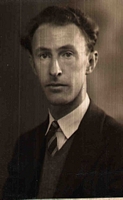 The pilot of the
aircraft was Herbert John Newby. He was born in
1914 in Cardiff to Harold Leo and Ella Newby.
The pilot of the
aircraft was Herbert John Newby. He was born in
1914 in Cardiff to Harold Leo and Ella Newby.
Herbert's brother Thomas was killed in action with 9 Squadron
in the summer of 1942.
He married a local woman Elizabeth Mary O'Neill at
Christchurch, Leeson Park in Ranelagh, Dublin on the 5th October
1943. Elizabeth was from Grangemore, Kilcullen.
Herbert was like the other crew members released from internment
in Gormanstown on 15 June 1944. His escape and evasion
interview report was much shorter than Fred Tisdalls, recording
only:
My experiences up to the time of baling
out are as related by P/O TISDALL in his report.
I baled out and landed in a bog near CHURCHILL, Co.
DONEGAL, EIRE on 2 Oct 41. I was arrested by the police and
interned at the CURRAGH Camp until 16 Oct 43, and at
GORMANSTON until 15 Jun 44, when I was sent to the U.K.
I was concerned in the tunnel attempt started in Dec
43, which is described by P/O TISDALL in his report.
He was commissioned as a officer in 1945. The Royal Aero
Club archives hold a card for him dated from 1947, recording his
having obtained a private pilots license in 1947 with Cambrian
Air Services. His profession is listed as Air Traffic
Control on the record card. In 1952, a newspaper article
in
Herbert was for many years the Air Traffic Control manager of
Aberdeen Airport in the 1970's and appeared in many newspaper
articles relating to the airport, especially when members of the
British royal family passed through the airport.
Herbert Newby passed away in 1998 in Bucksburn, Scotland.
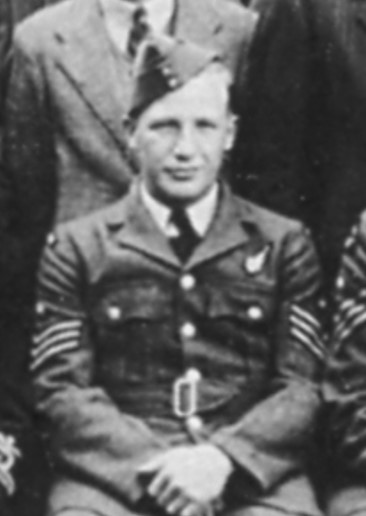 Frederick
William Tisdall was born on 2nd December 1915 in Toronto,
Canada to Frederick and Jemima Tisdall
Frederick
William Tisdall was born on 2nd December 1915 in Toronto,
Canada to Frederick and Jemima Tisdall
Fred married Majorie E Wilson in October 1940 in XXXX
Frederick enlisted in Moncton on the 21st June 1940. His
initial postings indicate that he was first sent to train as a
pilot, but was later reasinged as a trainee Observer, or
navigator. His name was published in Canadian newspapers
as having graduated from No,1 Bombing and Gunnery School in
March 1941 and from there he was posted to No.1 Air Navigation
School, Rivers, Manitoba. He trained there for the
following two months and was embarked for the United Kingdom on
18 May 1941. His escape and evasion report recorded his starting
RAF service on 6 Jun 1941. He arrived in Ireland with the
rank of sergeant and the enlisted man serial number R/64726 and
left as a commissioned officer with serial number CAN/J38641.
All members so the crew recorded their presence at No. 16
Operational Training Unit at Upper Heyford, and this is likely
where they first formed a crew before posting to 106 Squadron.
His internment in
Ireland was announced in various Canadian newspapers on the
8th October 1941, when initial news reached his
family. He was officially posted as missing, but word
had reached his father as early as October 7th that he was
apparently in Eire.
Moncton Airman Reported Missing
MONCTON, N. B. Oct. 6-(Special)- Word was received here
today that Sergeant Observer Fred W. Tisdall, of the R.C.A.F.
is missing following air operations overseas. Sergeant
Observer Tisdall is a son of Mr. and Mrs. Fred
Tisdall, Brydges Street, and enlisted time ago in the
R.C.A.F. gaining his observer's half wing and proceeding
overseas shortly after. He was a well known athlete and
played on several Moncton softball clubs, being one of
the best outfielders turned out in this locality.
His wife is the former Marjorie Wilson. Ralph
Tisdall is brother while Mrs. Sammy McManus and Mrs.
Ralph Barnett are sisters.
On the 8th of
November 1941, newspapers across Canada published various
versions of a newspaper report where Frederick Tisdall had
written to his wife and extracts were published country
wide.
Upon his release, he was interviewed by the MI9 organisation
and the following file was created of his recollections.
It is not understood what the reference is to Frankfurt as the
target of his bombing mission.
1. Internment.
I was a member of the crew of a Hampden aircraft which left
CONINGSBY on 1 Oct 41 to bomb FRANKFURT. We reached our
target and dropped our bombs, and on the return journey we
were chased by fighters and got badly off our course.
After encountering various difficulties we ran out of petrol
and were compelled to bale out over EIRE, coming down near
CHURCHILL, Co. DONEGAL on 2 Oct. We were then interned in
the CURRAGH Camp.
2. Attempted Escapes.
I was concerned in both escape attempts from the CURRAGH
Camp -
the ladder attempt on 9 Feb 42 and the gate-lifting attempt
on 17 Aug 42 as described by Lieut. GIRDLESTONE
(I.S.9(W)/REP/E/21), but did not get out of the camp.
In Oct 43, when the previous party were repatriated, we were
moved to GORMANSTON Camp, Co. MEATH. There were then 10 of
us, but since then Sgt. TAYLOR (I.S.9(W)/REP/E/24) and Sgt.
ROSS have been repatriated.
In Dec 43 we started a tunnel at GORMANSTON. The opening to
the tunnel was underneath our sleeping quarters. The hut in
which we slept was built on a low concrete wall, and we
managed to make an opening in one of the unoccupied cubicles
and work down and then towards the wire.
Late in Apr 44 the camp with authorities had a raid and
stopped the tunnel. They told us that they had known
for some time that we were working at it.
Repatriation from EIRE.
On 13 Jun 44 a representative of the United Kingdom office
came to the camp and told us that negotiations were under
way to repatriate us.
On 14 Jun we were confined to camp after 1800 hrs. At about
1930 hrs representatives of the United Kingdom office told
us that we were leaving next
morning at 0600 hrs. We were taken to KINGSTOWN, where we
met S/Ldr. GARDINER, who escorted us to this country.
We left KINGSTOWN at 0800 hrs and arrived at HOLYHEAD at
1200 hrs on 15 Jun.
It is not clear what if any service he carried out after his
release from internment but he was returned to Canada 12th
August 1944 and posted to No.1 Air Observer School (AOS) in
September 1944 before retiring from the services in February
1945. The ORB of No 1 AOS recorded his arrival at the
training unit as his arrival for refresher training from No 1
Repatriation Depot.
Frederick died on 7th Nov 1992 Pinellas, Florida and is buried
in Fair Haven Memorial Gardens, Moncton.
 The
third crew member was James Wakelin, born in 1921 in Stoke on
Trent to Thomas and Mary Wakelin. By 1939, they can be
found living in Newscastle-under-Lyme at the family home named
Roselea. James gives his occupation on the 1939 register
as
The
third crew member was James Wakelin, born in 1921 in Stoke on
Trent to Thomas and Mary Wakelin. By 1939, they can be
found living in Newscastle-under-Lyme at the family home named
Roselea. James gives his occupation on the 1939 register
as
On the 10 of October 1941, his local newspaper published his
photo along with a short article
Perhaps as an illustration of the nature of internment in
Ireland, when his father Thomas died on 13 June 1943, James was
allowed to go to England for 2 weeks for the funeral! On
his father's wills calender entry, James Wakelin, Traffic Clerk,
is listed as beneficiary. Just two days before his fathers
death, James engagement to Irene Hughes was printed in the local
paper, the Evening Sentinel. In it he is described as "Sergeant James Wakelin W/O A/G RAFVR
prisoner of war in Eire, only son of Mr and Mrs T Wakelin."
Like the others, he was released in June 1944, arriving in
Holyhead on the 16th. He filed just a short report after
his MI9 interview, worded exactly the same as Newby.
Following his return home, he married Irene Hughes, and they
had two daughters. James died in December 2002 in Stoke on
Trent,
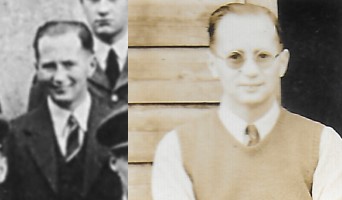 The
last member of the crew was David Reid, the Rear Gunner,
from North Berwick in Scotland. David was born in November
1915 in Langholm to XXX
The
last member of the crew was David Reid, the Rear Gunner,
from North Berwick in Scotland. David was born in November
1915 in Langholm to XXX
His post internment interview is the same as Newby and Wakelin,
other than he records having landed on a mountain near
Churchill. His RAF service had begun in May 1939.
Some of the men appear in two group photos that came from the
family of G C Slator, a crew member from Wellington Z1676 who
remained interned with AD768's crew until June 1944. By
comparing with the Tee's wedding photo and some other
photos, those below seem to show the following personnel:
Top Step, left to right: Reid, Diaper, Wakelin
Front row, Newby and Thomas
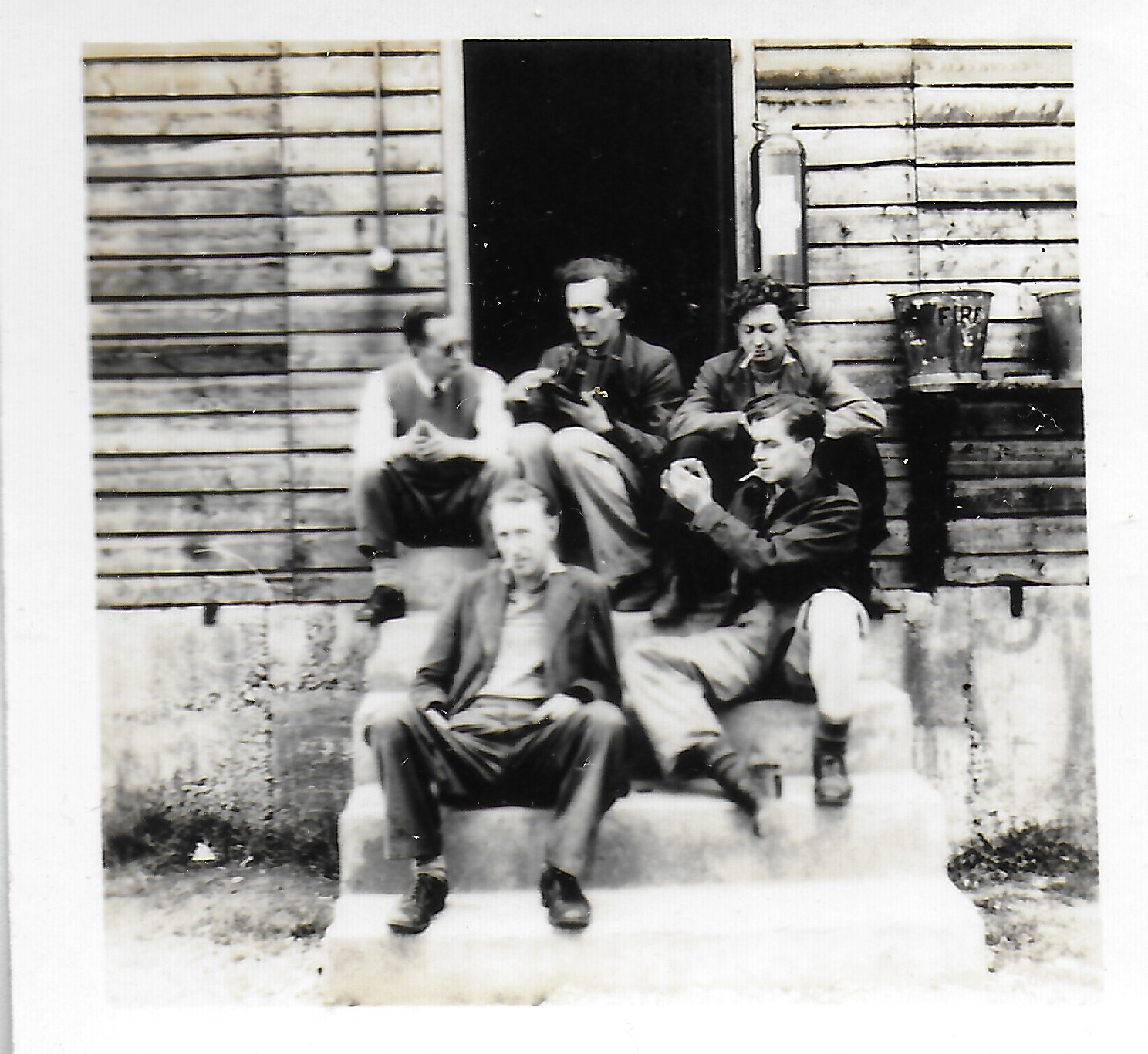
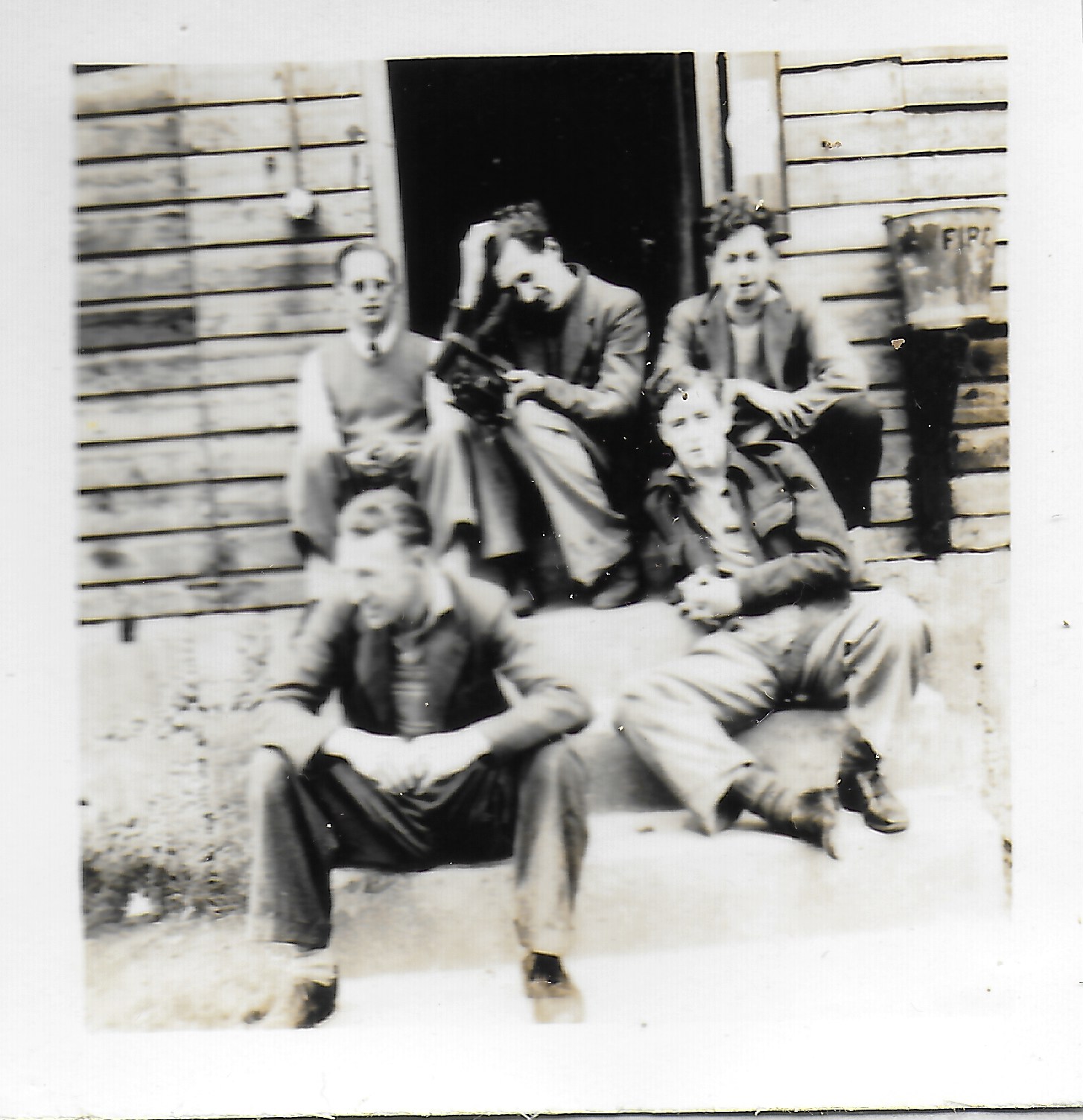
In addition to those, it appears that at least three of the
internees, two from this crew, were members of Drogheda Rugby
Football Club during the 1943-44 season. The side image is
that of a D E M Ross, G C Slater is named at the front right and
the man at the rear left hand side is a D Reid.
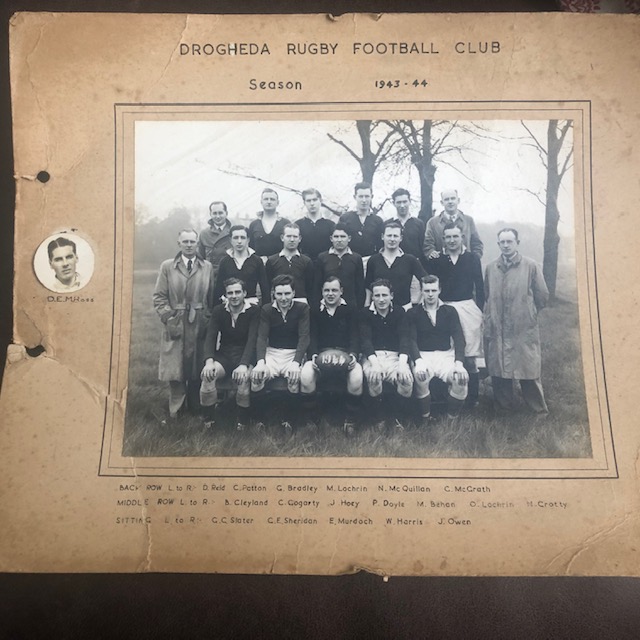
The aircraft involved was a Handley Page Hampden. This
was an aircraft built by the English Electric company and
delivered to the RAF in January 1941. It was assigned to
106 Squadron and it served for a few weeks until it was damaged
when its landing gear was accidentally retracted. Its Form
78 history card shows it assigned to 43 Maintainance Group and
subsequent to that it returned to the unit prior to its loss
over Donegal.
John Quinn in his 1999 book, Down in a Free State recorded his
visits to the crash site.
Compiled by Dennis Burke, 2024.
